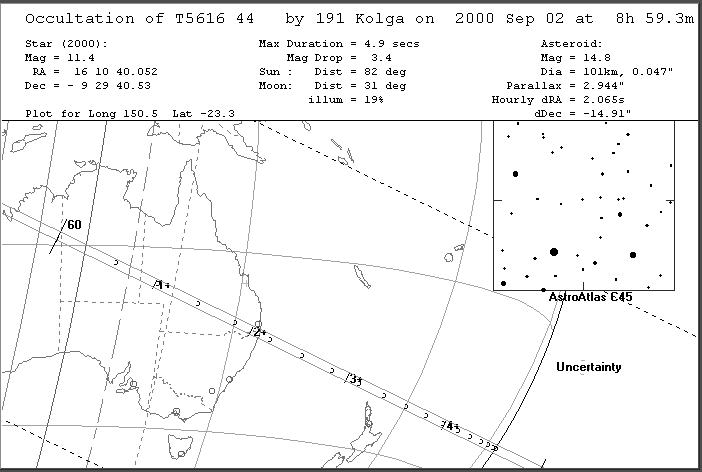ASTROMETRIC UPDATE:
OCCULTATION BY (191) KOLGA - 2000 SEPTEMBER 2
CHECK THIS PAGE REGULARLY FOR FURTHER UPDATES AND CHANGES TO THE TRACK.
YOU MUST RELOAD THIS PAGE USING YOUR BROWSER'S
RELOAD/REFRESH BUTTON TO OBTAIN UPDATES!
[Prediction by Edwin Goffin]
[Prediction using OCCULT software]
[Detailed finder chart by Stephen Kerr]
Goffin's path runs from the north-west crossing the Kimberley area in daylight then on to the central part of the Northern Territory at local sunset and southern Queensland. The path runs very close to Brisbane before crossing the northern Tasman Sea passing to the north of the North Island of New Zealand. The path given by OCCULT is virtually indistinguishable, passing through the northern suburbs of Brisbane and Sunshine Coast area around 20 seconds earlier than Goffin's path.
UPDATE: 30 August 2000
This prediction update has been computed by Stephen Kerr based on astrometry from Ron Stone of the US Naval Observatory - Flagstaff Station. The ACT position of the target star has been used.
Summary:
This update indicates a shift in the predicted path to the south-west of around 1.5 path widths relative to Goffin's prediction and slightly (5 - 10 second) earlier. The path now crosses the southern parts of the Darling Downs and the southern limits of the Brisbane metropolitan area as well as the Gold and Tweed coast areas (around 9:02 UT). Observations from the North Island of New Zealand will also be very worthwhile. The closest approach of the path to New Zealand is around 9:03:20 UT when it will pass only 3 path widths to the north of Auckland - obviously Whangarei and Northland will be even closer.
Observers should note that the target star is the fainter of a pair. The magnitude 9.7 star TYC 5616 37 is only 60" to the north east of the target star. The two star images are not clearly seperated in the charts on Edwin Goffin's predictions. A more detailed finder chart is attached to this update and can be reached by clicking here.
THE EVENT AT ONE GLIMPSE:
- Date and approx. UT time of event: September 2, 2000 @ 8:59 UT
- Magnitude of target star: 11.4
- Magnitude drop [mag]: 3.4
- Estimated maximum duration [s]: 5.1
- Path description: See above.
- Goffin's original chart reference: A00_0909
The Occultation Path:
- Approximate width [km]: 110
- Map: See below
- Circles along the path are OCCULT calculated exact centerline points !!!!
Data for the target star:
- Name: TYC 5616 00044
- Constellation: Scorpius
- J2000 position [h,m,s; o,',"]: 16h 10m 40.052s; -09o 29' 40.53"
- Position source: ACT
- Estimated accuracy ["]: 0.11" (0.09", 0.07")
- V mag [mag]: 11.44
- B-V [mag]: +0.51
- Remarks:
- The target star is in far north-western Scorpius. The magnitude 4.9 star psi Scorpii lies 40' to the south-east of the target star. As mentioned earlier, the magnitude 9.8 star TYC 5616 00037 = SAO 141012 lies only 60" to the north-east of the target stars. This star and the target star are not resolved in the charts prepared by Edwin Goffin.
Two detailed finder charts have been prepared and can be reached by clicking here.
Data for the minor planet:
- Number, name: (191) Kolga
- Approx. diameter [km]: 105
- Source of used astrometry: US Naval Observatory - Flagstaff Station (Ron Stone)
- Number of used observations: 32
- Number of rejected observations: 0
- Time covered by the observations: 2000 03 04 - 2000 07 20
Data for the event:
- UT date and time of least geocentric approach: 2000 September 2, 8:59.3 UT
- Approx. V mag of minor planet at event [mag]: 14.83
- Geocentric parallax of minor planet ["]: 2.94
- Magnitude drop [mag]: 3.4
- Estimated maximum duration [s]: 5.1
- Apparent motion of minor planet ["/h]: 33.99
- Angular distance to moon, phase of moon [deg,%]: 31, 19%
- Update computed by: Stephen Kerr (Win OCCULT 1.2).

IMPORTANT NOTE!
Astrometric updates such as these should not be taken as definitive, but rather only as an indication of where the true track may lie relative to the original predicted track. Observers must bear in mind that later astrometry, in which the target star is measured in the same field as the asteroid, may still reveal substantial changes to the predicted track and time of the event. For this reason it is most important that observers far from the predicted track still monitor the event.
Use these links for further information:
[Planetary Occultations]
[Using the Predictions]
[Observing Details]
[Timing Details]
[Reporting Details]
[Report Form]
[Asteroid Occultation Results]
This page may have been updated since 30 August 2000.
Hit your browser's RELOAD button to get the latest version.
[Site Map]
[What's an Occultation?]
[Total Occultations]
[Grazing Occultations]
[Planetary Occultations]
[Jovian Satellite Eclipses]
[Timing Occultations]
[Reporting Observations]
[Coming Events]
[Software]
[About Us]
[Publications]
[Membership]
[Links]
[Top of Page][Return to Home Page]
